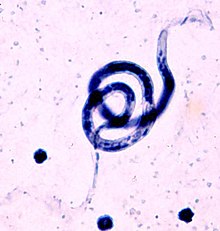| Brugia malayi | |
|---|---|

| |
| B. malayi, blood smear, Giemsa stain | |
| Scientific classification | |
| Domain: | Eukaryota |
| Kingdom: | Animalia |
| Phylum: | Nematoda |
| Class: | Chromadorea |
| Order: | Rhabditida |
| Family: | Onchocercidae |
| Genus: | Brugia |
| Species: | B. malayi
|
| Binomial name | |
| Brugia malayi S.L. Brug, 1927
| |
Brugia malayi is a filarial (arthropod-borne) nematode (roundworm), one of the three causative agents of lymphatic filariasis in humans. Lymphatic filariasis, also known as elephantiasis, is a condition characterized by swelling of the lower limbs. The two other filarial causes of lymphatic filariasis are Wuchereria bancrofti and Brugia timori, which both differ from B. malayi morphologically, symptomatically, and in geographical extent.[1]
B. malayi is transmitted by Mansonia mosquitoes and is restricted to South and Southeast Asia. It is one of the tropical diseases targeted for elimination by the year 2020 by the World Health Organization, which has spurred vaccine and drug development, as well as new methods of vector control.
- ^ Johhn, David T., and William A. Petri. Markell and Voge's Medical Parasitology. 9th ed. St. Louis: Saunders Elsevier, 2006.